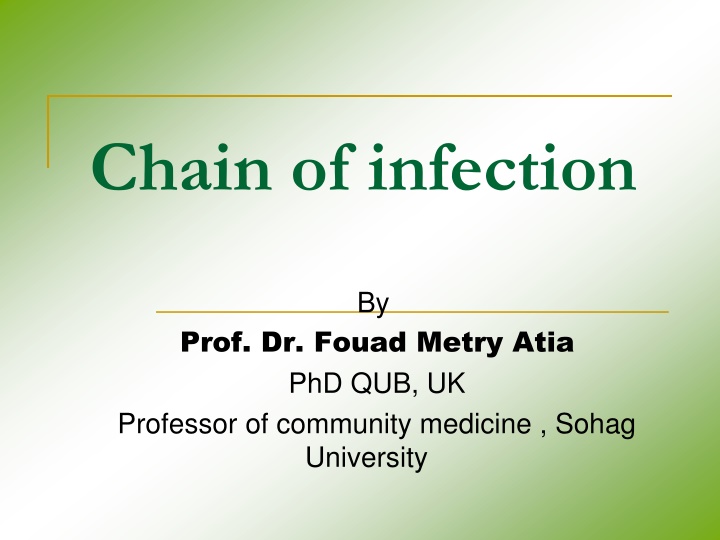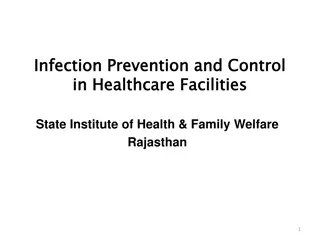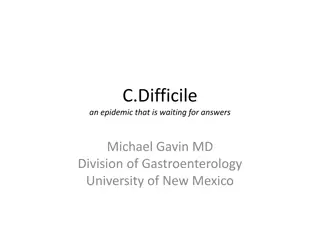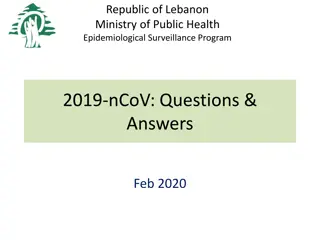
Chain of Infection and Microbiologic Agents
"Learn about the chain of infection, types of infectious agents like bacteria, viruses, rickettsia, protozoa, and fungi, their characteristics, and associated diseases. Explore the portal of entry, reservoir, mode of transmission, and more in this informative guide by Prof. Dr. Fouad Metry Atia, Professor of Community Medicine at Sohag University."
Download Presentation

Please find below an Image/Link to download the presentation.
The content on the website is provided AS IS for your information and personal use only. It may not be sold, licensed, or shared on other websites without obtaining consent from the author. If you encounter any issues during the download, it is possible that the publisher has removed the file from their server.
You are allowed to download the files provided on this website for personal or commercial use, subject to the condition that they are used lawfully. All files are the property of their respective owners.
The content on the website is provided AS IS for your information and personal use only. It may not be sold, licensed, or shared on other websites without obtaining consent from the author.
E N D
Presentation Transcript
Chain of infection By Prof. Dr. Fouad Metry Atia PhD QUB, UK Professor of community medicine , Sohag University
Infectious agent Susceptible The chain of infection Portal of entry Reservoir Mode of Portal Of exit transmission
I. MICROBIOLOGIC AGENTS Bacteria: Bacteria are a varied group of unicellular micro-organisms which vary in size from a fraction of a micron to about 12 microns. Bacteria responsible for human diseases are classified morphologically into Cocci e.g. pneumococci, meningococci, staphylococci, streptococci.
Bacilli. Examples are salmonella typhi and para typhi, shigella, brucella, corynebacterium diphtheria and tubercle bacilli. Some bacilli can grow anaerobic as tetanus and gas gangrene bacilli. Spirochaetes. The spirochaetes that are pathogenic to man include Treponemas e.g. T. pallidum (Syphilis). Borrelias e.g. B. recurrentis ( louse borne relapsing fever) and B. duttoni (Tick borne relapsing fever), Leptospiras e.g. L. icterohaemorrhagica (Weil's disease). Vibrios e.g. Vibrio cholara and Vibrio El- Tor.
Viruses: These are minute micro-organisms which multiply within suitable living cells and can not be seen by the ordinary microscope. They vary in size from 20- 300 millimicrons. Viruses are the causative agents of a large number of diseases including measles, mumps, chicken pox, influenza, common cold, poliomyelitis, small pox, yellow fever, dengue fever, and herpes zoster.
Rickettsia: Rickettsia can only grow in living cells Like viruses but they can be seen under the ordinary microscope. Disease Rocky Mountain spotted fever Epidemic typhus Murine typhus Q fever Scrub typhus of western Pacific Trench fever Causative agent R. rickettsii Vector Tick. R. prowazeki R. mooseri R. burneti R. tsutsugamushi Louse Flea Milk or air Mite R. quintana Louse
Protozoa: these are unicellular animals. Malaria Amoebic dysentry. Sleeping sickness Kala azar (Plasmodium malariae). (Entamoeba histolytica). (Trypanosomas). (Leishmania). Fungi : They may cause the following human diseases : Ring worm of the scalp. Ring worm of the body. Favus. Ring worm of the grein. (Microsporum audouini). (Microsporum canis). (Microsporum schoenleini). (Epidermephyten insuinale).
Parasites : These are animals which live on or within other organisms. Examples of human diseases caused by parasites include Bilharziasis by bilharzia worms, Elephantiasis by filaria worms, Hook worm infections as Ancylostomiasis by anchlostoma worms and Hydatid disease by taenia echinococcus.
II. RESERVOIRS AND SOURCES OF INFECTION The reservoir of infection may be man, animals, or soil in which the infectious agent, lives, and depends on primarily for survival and multiplies in a way that enables it to be transmitted to a susceptible host.
Source of infection is person, object or substance from which an infectious agent passes immediately to the host. The source may be: A vehicle e.g. contaminated water in typhoid fever. A vector e.g. infective mosquito in malaria. Contaminated articles e.g. A toy or other utensils in case of diphtheria.
Reservoirs of infection are classified into: 1. Cases : These are the main reservoir of infection whether typical or subclinical (inapparent, missed).
Inapparent cases are those cases in which infection is so mild that it is not recognized clinically. However, evidence of infection could be demonstrated by laboratory methods. In fact, infection causing subclinical cases is the rule rather than the exception in many diseases and amount to 90% or more of all the infections e.g. in poliomyelitis.
2. Carriers: A carrier is a person who harbours a specific infectious agent without showing symptoms of clinical disease.
Carriers are dangerous reservoirs of infection because : A carrier does not display any clinical manifestations. The carrier and his contacts are unaware of the fact that he can infect them and consequently they do not take any precautions.
It is not always easy to discover carriers because laboratory examinations, which may not always be easy or practical, are usually required. It is not always possible to deal with carriers effectively e.g. if the typhoid carrier is the housewife who could not be prevented from preparation, and handling of food. The number of carrier is much greater than cases and they are free to move in the community.
Classification of carriers: Chronologically carriers are classified into: Contact carriers: contacts of cases or carrier may get infected but not diseased e.g. doctors, nurses, parents of an ill person. Usually eliminate infection in about two weeks. Incubating carriers: They are persons who discharge the micro-organisms during the incubation period e.g. in the case of measles, mumps, infective hepatitis and poliomyelitis.
Convalescent carriers: They are defined as persons who discharge the microorganisms during the convalescence period. They are the commonest type of carriers. Sometimes the carriers may remain so after the convalescence period i.e. post convalescent carriers as in typhoid fever (they amount to about 5% by the end of the third month).
This is why release samples are required after clinical cure before releasing patients suffering from diseases in which a carrier state is known to develop. As a rule the patient is not discharged until it is proved by the laboratory means that the samples are free from the infectious agent on three consecutive bacteriological examinations.
According to the duration of carriage, carriers are classified into : Temporary carriers : they are persons who carry the microorganism for a period less than three months (except in typhoid, where the period is for less than one year). Chronic carriers: In this type of carriers the person harbours the microorganism for years.
Carriers may discharge the microorganisms continuously without intermission or the microorganism may not be shown in the carrier's excreta for a period of time to appear again latter and hence named intermittent carriers. This is why suspected persons should be examined three times consecutively before excluding the carrier state.
According to the place of carriage, carriers are classified into: GIT carriers. e.g. Typhoid and paratyphoid bacilli. viral hepatitis and amoebic cysts . Respiratory carriers e.g. Meningococci, diphtheria bacilli, streptococci and staphylococci. Urinary carriers; e.g. typhoid and partyphoid bacilli and Brucella melitensis. Skin carriers; e.g. staphylococci. This also include nasal carriers because the lining of the nose is nothing but a fold of skin.
Dangerous group of carriers: Certain occupational groups giving public services or care of vulnerable : Food handlers Nurses in care of children. Hospital personnel School personnel
3. Animals: Although animals have their special infectious diseases. Some of these diseases can be transmitted to man under natural conditions (such an infection is called a ZOONOSIS). Transmission of infection from animal to man could be by contact or through eating the flesh or products of infected animals or by a vector as in plague and yellow fever.
The most important zoonosis are : Rabies, bovine tubereulosis, undulant fever, salmonellosis, Q fever, bubonic plague, tape worm infection and anthrax.
4-Other reservoirs of infection: In addition to the three main reservoirs discussed above, the soil is considered the reservoir in coccidioidomycosis, histoplasomosis and probably in blastomycosis. These organisms can propagate in the soil. In the case of tetanus and botulism, animals are considered the reservoir and the spores, the infective stage, are to be found in the soil.
Arthropods are considered reservoirs if the agent passes from one generation to the other transovarian as in the case of ticks in tick borne relapsing fever.
III. PORTAL OF EXIT 1. The alimentary canal: The microorganisms leave the bowel with the foecal material in diseases that affect primarily the digestive tract e.g. typhoid, paratyphoid and bacillary dysentry, the eggs of ascaris, ancylostoma, B. mansoni.
Sometimes, the microorganisms may leave the gastro intestinal tract with the vomitus in diseases where vomiting is a main manifestation as in the case of cholera and food poisoning.
2-The respiratory tract: The respiratory tract is the portal of exit in measles, influenza, whooping cough, common cold, diphtheria. (laryngeal and nasal types) mumps, pulmonary tuberculosis, streptococcal throat infections (sore throat, tonsillitis and scarlet fever), small pox, chicken pox pneumonias and pneumonic plague.
The microorganisms leave the respiratory tract of cases or the carriers during coughing, sneezing, talking or even during ordinary respiration. Microorganisms leave the respiratory tract in what is known as infective droplets. The very small droplets are more dangerous than the large ones, because they are more likely to remain suspended in the air and reach the susceptible host.
It should be noticed that the mouth is more important than the nose as an exit for microorganisms except if the lesion is in the nose. Even in case of sneezing, the mouth contributes more than the nose. Microorganisms present in nasal secretions spread more by indirect contact through handkerchiefs, bed cloth and fingers..
3. The urinary tract: The microorganisms may leave the body of the reservoir with the urine as in typhoid and undulent fever and also occur when infection is local in the genito-urinary tract as in case of gonorrhea and other venereal diseases and in urinary typhoid carriers, or when the eggs of a parasite are extruded during urination as in schistosoma haematobium.
4. Discharges from skin and/or mucous membrane lesions: Skin lesions may be one of the manifestations of a general disease e.g. chicken pox (and small pox in the past) or they may be the main disease manifestation as in impetigo and other bacterial infections of the skin. Also, discharges from the conjunctival sac are of specific importance in case of acute and chronic conjunctivities.
5. By insect bites: The microorganisms are found in the peripheral circulation of man and or animals in some diseases and can be transmitted by suckling insects. The following are of public health importance among the blood sucking insects which play a role as vectors in the transmission of human diseases:
Mosquitoes: The anophelines transmit malaria, aedes transmit yellow fever, dengue fever and viral haemorrhagic fevers and the culicines transmit filariasis, west Nile fever and virus encephalitis. Lice: transmit epidemic typhus, epidemic louse borne relapsing fever and trench fever. Fleas: Transmit plague and murine typhus. Ticks: Transmit tick borne relapsing fever, rocky mountain spotted fever and tick fever. Sand Flies: Transmit kala azar and sand fly fever. Tse Tse Flies; Transmit trypanosomiasis.
6. In utero transmission: Some of the micro-organisms can reach the foetus in uterus e.g. the viruses of german measles, small pox, the spirochoetes of syphilis.






















